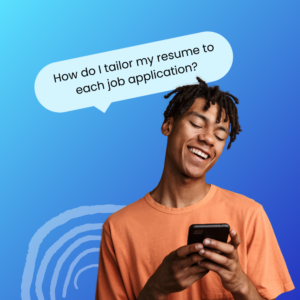Proofreading Techniques to Ensure an Error-Free Resume

When you’ve spent time and effort perfecting your resume, the last thing you want is a haphazard spelling error to hurt your chances of getting hired. Thorough proofreading is essential to ensure your resume makes it through the screening process and conveys your experience positively and accurately.
Before you hit the ‘apply’ button, follow the proofreading resume tips below to submit a polished, mistake-free document.
Why proofreading your resume matters
It keeps the focus on your accomplishments
To a discerning reader, a typo sticks out like a sore thumb. Unfortunately, this puts their focus on a negative aspect of your candidacy instead of a positive one. An error-free resume keeps attention where it belongs: on your qualifications and achievements.
It presents a positive image
Mistakes in your resume call your credibility into question. If you’re able to overlook flaws in this important document, a hiring manager might wonder what blunders you would be likely to make in other aspects of your job.
Proofreading your resume ensures you present the image you want to present: one of professionalism, expertise, and a high level of care for the quality of your work.
It prevents your resume from being screened out
A hiring manager can’t make an assessment of you if they never get to see your resume–which is exactly what could happen if you make a mistake that causes an automatic screening system to eliminate you from consideration.
Applicant tracking systems, also known as ATSes, screen resumes for keywords that are important to the search, like skills and credentials. If you misspell one of these terms, it might not be recognized by the system and could cause your application to be disqualified.
Things to look for when proofreading your resume
Spelling
Look out for missing letters, common mistakes like misplacing ‘ie’ where it should be ‘ei,’ words with double consonants like ‘accommodate,’ and notoriously tricky words like ‘license’ and ‘necessary.’ Also, verify that you have the correct spelling of any names of people, companies or products included in your resume.
Grammar
Seventy-seven percent of hiring managers said typos and poor grammar would be an instant deal breaker in a resume. Unfortunately, automated tools don’t easily catch grammar mistakes and instead require a human eye to correct them. Acquaint yourself with the most common grammatical errors and watch for them in your writing.
One of the most frequent grammar mistakes on resumes is ‘affect’ versus ‘effect.’ Affect is almost always a verb: ‘My actions affected the company’s performance.’ Effect is usually a noun that results from someone’s actions: ‘The company benefited from the effects of my project.’
Homonyms
Homonyms are words that sound the same but have different spellings and meanings. A computer’s spell-check tool won’t always catch these, and they can really reflect poorly on you.
Here are a few of the biggest homonyms to pay attention to:
- Your/you’re
- To/too/two
- There/their/they’re
- Than/then
Capitalization
Ensure proper capitalization of words that require it, including company names, cities and states, days and months, and languages.
Numbers
Numbers are one of the easiest typos to make as you draft your resume and are also easy to miss when proofreading. Review employment dates, performance stats, and any other aspect of your resume that cites a numeric figure to ensure you’ve entered the information correctly.
Consistency
Consistency isn’t so much a matter of right and wrong as readability. Keeping things consistent throughout the entire document makes it easier to scan and, once again, keeps the focus on your strengths as a candidate rather than mistakes.
Some examples to be mindful of are verb tense (‘manage a team of six’ versus ‘managed a team of six’) and punctuation (like using a period or no period at the end of each bullet point). Pick one style and use it through your resume.
Links
Most modern resumes are submitted as a PDF, which means they can contain links. Verify that all hyperlinks, like your email address, LinkedIn profile or online portfolio, are correct and functioning properly.
Repeat words and phrases
We all have go-to words and phrases we use frequently. While repeat words aren’t necessarily a deal-breaker, they can distract a reader and decrease the impact of your statements. A duplicate word finder can help you identify repeat sections of text so you can come up with an equally impactful alternative.
Looking for a professional resume writing service to do the heavy lifting? We suggest using BeamJobs!
Proofreading resume techniques
1. Give it time
If at all possible, avoid writing your resume and proofreading it in the same session, especially if you’ve been looking at the screen for several hours. Give your mind and eyes a break, then return after a few hours or even the next day for more precise editing.
2. Print it out
Some errors are more noticeable on paper than on a screen, so do at least one editing sweep with a hard copy of your resume. Use a horizontal ruler to work your way down the printed page, forcing yourself to focus on one line at a time.
3. Read it out loud
Your ears are great for catching mistakes your eyes may have missed. Read your resume slowly out loud, paying attention to anything that sounds off. This can also help you swap out awkward words for ones that sound more natural.
4. Look for one thing at a time
It can take several passes to catch every error, so don’t try to do it all in one sitting. Do a few proofreading sessions, each time, focusing on a different aspect (spelling, grammar, formatting, etc.).
5. Use a proofreading app
In addition to the spell check tool built into your word processing program, several other apps can catch mistakes these tools miss. Grammarly can correct grammar mistakes while providing suggestions to improve the clarity of your writing. At the same time, the Hemingway app can help you avoid passive voice, make more robust word choices, and streamline your writing.
6. …But don’t rely too heavily on apps
Apps are great for catching obvious misspellings and egregious grammar errors. However, other slip-ups can slide under the radar, like words that are spelled right but used incorrectly.
For example, let’s say you meant to type “collaborated with colleagues on a marketing plan,” but instead, type “collaborated with colleges on a marketing plan.” You haven’t misspelled a word, but you’ve completely changed the meaning of your statement. This could give a hiring manager an incorrect impression of your work.
7. Get a Second (or third) opinion
Some errors can sneak past you no matter how often you review your document. This is why it’s so important to enlist help from a third party who can proofread your resume with fresh eyes. You might even consider hiring a professional proofreader; they’re easy to find on a site like Upwork or Fiverr.
The few extra minutes it takes to proofread your resume can make the difference between landing an interview and getting passed over for a job. By carefully reviewing your document before you apply, you’ll make the best possible impression on the people (and software) reviewing your candidacy.
Want more helpful tips for creating a compelling, impactful resume? Check out these related posts:

